Tokaj (Slovakia)
Tokaj wine region (Slovak: Vinohradnícka oblasť Tokaj[3]) is a wine-growing region located in south-eastern Slovakia and north-eastern Hungary. The two vine-growing areas were once part of the greater Tokaj wine region (also Tokaj-Hegyalja wine region or Tokaj-Hegyalja) of the Kingdom of Hungary. Following the Treaty of Trianon, a smaller part (3 villages and about 175 hectares of vineyards) became part of Czechoslovakia, and after 1993, Slovakia. The majority of the region (around 28 communities and some 5,500 hectares of vineyards) remained part of Hungary.
| Wine region | |
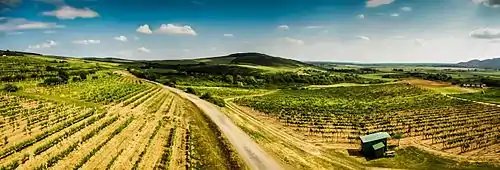 | |
| Official name | Vinohradnícka oblasť Tokaj |
|---|---|
| Country | Slovakia, Hungary |
| Climate region | Continental climate |
| Precipitation (annual average) | 550 mm |
| Soil conditions | rocky with volcanic origin |
| Total area | 908,11 ha[1] |
| Grapes produced | Furmint, Lipovina, Muškát žltý, Zéta |
| Varietals produced | Tokaji |
| No. of wineries | Tokaj Regnum Association[2] |
Nowadays, the Slovak part of the Tokaj wine region comprises 7 communities and approximately 908 hectares of vineyards.[1] Under the current EU legislation, the vintners in the Slovak wine region of Tokaj may use the Tokaj label (or Tokajský/-á/-é which means “of Tokaj” in Slovak).[3][4]
History
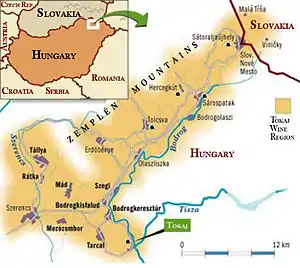
Vine growing in Tokaj wine region goes back to the Roman times, when the area belonged to the Roman province of Pannonia. After the fall of the Roman Empire, the vine growing tradition was continued by Slavs. It is believed that the name of the village and mountain Tokaj has a Slavic origin. It is derived from the word “Stokaj,” loosely referring to a confluence of two rivers, in this case the rivers Bodrog and Tisa.
Legend says that when Hungarians, led by Álmos and his son Árpád, reached this area, viticulture had already been flourishing. Árpád's valiant knight Turzol was first to climb the summit, and on return he reported to his master that the hillside was covered throughout with tranquil vineyards. Árpád then awarded Turzol not only with the hill, but also the entire area up to the intersection of the Bodrog and Tisza rivers. The village of Turzol was built here (today Tarcal). In 1241, the invasion of Tatars left the area plundered and its vineyards destroyed. King Béla IV of Hungary (1235-1270) decided to bring a new life to the region and colonized it by Latin people.
The settlers were probably Walloons from northern France, although some researchers claim that those were Italians. The Slovak village of Bara (Hungarian: Bári) was colonized by Italian settlers who brought with them new wine growing skills and traditions, as well as a base variety Furmint.[5] After the Turkish wars which began in 1528, the region stayed under Turkish rule for 170 years. Most of Tokaj cellars date back to that period, when they were built as hideouts for people and property from the plundering soldiers.
Around 1620 the emperor imported a wallonian-French winefarmer Duvont, who later invented the later known "king of wines"-methode in the Tokaji-district. In honour of Mr. Duvonts exceptional skills, the emperor ennobled this farmer, and gave him one of his many villages (Kiralyfalva) now Königsdorf in Austria. The emperor then named the family Királyfalvy.
Tokaji wine became an increasingly important commodity for the region from the 17th century, its export being a major source of income for the ruling princes of Transylvania to which the Tokaj region belonged at the time. Indeed, revenues from the increasingly renowned Tokaji Aszú wine helped to pay for the wars of independence fought against Austrian Habsburg rule. The repute of Tokaji wine was enhanced when in 1703, Francis II Rákóczi, prince of Transylvania, gave King Louis XIV of France a gift of numerous bottles of wine from his Tokaj estate. Tokaji wine was then served at the Versailles Court, where it became known under the name of Tokay. Delighted with the precious beverage, Louis XIV declared it "Vinum Regum, Rex Vinorum" ("Wine of Kings, King of Wines").
In the 18th Century, Tokaj reached the height of its prosperity. Both Poland and Russia had become major export markets for its wine. Such was the importance of Tokaji in Russia, that the Russian emperors maintained a de facto colony in Tokaj in order to guarantee the supply of wine to the Imperial Court.
The partition of Poland in 1795 and subsequent imposition of customs duties dealt a severe blow to the exports of Tokaji wine and precipitated the economic decline of the region. However, this was only the first of three major crises for Tokaj. The second occurred when the phylloxera epidemic reached Tokaj in 1885 and destroyed the vast majority of the vineyards in a matter of years.
Division of Tokaj-Hegyalja
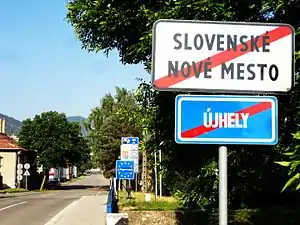

Following the signature of the peace Treaty of Trianon in June 1920, Hungary lost two-thirds of its territory, and the Tokaj wine region was divided between Hungary and the newly created Czechoslovakia. A state border has been set on the Ronyva creek and small suburb of Hungarian town Sátoraljaújhely (Kiskarlapuszta, Nagykarlapuszta, Állomás) was granted to Czechoslovakia (today Slovakia) and became a village called Slovenské Nové Mesto (English: Slovak New Town), (Hungarian: Újhely). Out of the historical Tokaj-Hegyalja wine region, Czechoslovakia gained an area of 175 hectares of vineyards and 3 villages: Malá Tŕňa (Hungarian: Kistoronya), Slovenské Nové Mesto (Hungarian: Újhely) and Viničky (Hungarian: Szőlőske). During the inter-war period, Slovakia's production of Tokaj wine was concentrated in Malá Tŕňa, which has always been the principal wine-growing locale in the area, and the local viticultural school was also located there (with instruction in Hungarian).[6] In 1924, a viticultural research station was built there in order to improve the vinegrowing and winemaking techniques in the region. Following the First Vienna Award in 1938, Hungary gained once again the territory and held it until 1944.
Not much has changed since the partition of the wine region. The majority of local population has been using Hungarian as their first language and they have preserved winemaking as well as other traditions just like before the Treaty of Trianon. The winemakers continued producing Tokaj wines according to the old Hungarian legislation (law of former ministry of agriculture n° XLVII from 17.12.1908).[7] In 1958, the research station in Malá Tŕňa prepared a proposal regarding the future development of the Tokaj wine region in Czechoslovakia. In 1959, the Czechoslovak government passed new legislation and expanded the region by adding 4 more neighboring villages: Veľká Tŕňa (Hungarian: Nagytoronya), Bara (Hungarian: Bári), Čerhov (Hungarian: Csörgő) and Černochov (Hungarian: Csarnahó). With addition of these new communities, the total surface of classified Tokaj vineyards became 703,10 ha. Another legislation has been passed in 1996, expanding the surface to 908,11 ha of classified Tokaj vineyards.[1]
A detailed map of the Slovak part of the Tokaj wine region has been drawn in 2016 and is visible on multiple tourist information panels on the Slovak side of the appelation.
Characteristics of the wine region
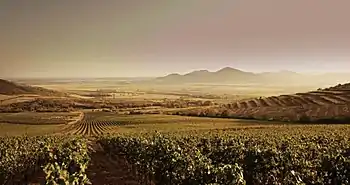
Tokaj wine region is one of a handful in the world whose conditions are favourable for growing grapes for naturally sweet wines. With its 908 ha, Tokaj is the smallest of the six vine-growing regions of Slovakia. It comprises 7 villages in the Trebišov District: Bara, Čerhov, Černochov, Malá Tŕňa, Slovenské Nové Mesto, Veľká Tŕňa, and Viničky.[8]
Some of the characteristics which make the Tokaj wine region unique are:
- Soil and microclimate: The Tokaj terrain consists of clay or loess soil on volcanic subsoil. The microclimate is determined by the sunny, south-facing slopes and the proximity of the Tisza and Bodrog rivers, and is conducive to the proliferation of Botrytis Cinerea (noble rot) and the subsequent desiccation of the grapes.
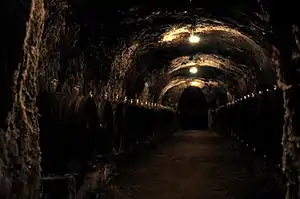
- Indigenous grape varieties: Furmint and Lipovina have been cultivated in the region for centuries and, together with Yellow Muscat and Zeta, are the only grape varieties officially permitted for use in the region.
- Cellars: A vast system of cellars has been carved out of solid rock. They provide a constant temperature of around 12 °C and high humidity of around 95%, which are ideal for the aging of Tokaji wines.
- Appellation system: A royal decree in 1757 established a closed production district in Tokaj, the world's first system of wine appellation. Vineyard classification began in 1730 and was completed by the national censuses of 1765 and 1772.
Winemakers and Wine Styles

Wine makers from the Slovak side of the border produce quality dessert as well as dry wines similar to those of the Hungarian wine region.[9] The Tokaj wines (Slovak: Tokajské víno) made exclusively from 3 base varieties Furmint, Lipovina and Yellow Muscat (Slovak: Muškát žltý) grapes, are:
- Tokajský Furmint
- Tokajská Lipovina
- Tokajský Muškát žltý (Yellow Muscat)
- Tokajské samorodné suché (samorodné derived from a Slovak word meaning "the way it was grown", suché means "dry"): Samorodné wine is set apart from ordinary wine in that it is made from bunches which contain a considerable proportion of botrytised grapes. Because of this, Samorodné is typically higher in extract than ordinary wine.
- Tokajské samorodné sladké (sladké means "sweet")is set apart from ordinary wine in that it is made from bunches which contain a bigger proportion of botrytised grapes.
- Tokajský výber (in Hungarian: aszú): This is the wine which made Tokaj world famous. It is a sweet dessert wine made by individually picking botrytised grapes and trampling them in huge vats to form a paste. Must is then poured on the paste and left to soak before the wine is transferred to wooden casks where fermentation in completed. The wines are graded from 3 to 6 putňa (Hungarian: puttony), representing the level of sugar and sugar-free extract in the mature wine.
- Tokajská výberová esencia (the Hungarian version is called aszú-eszencia)
- Tokajská esencia-nektár (meaning "essence-nectar")
- Tokajský mášláš (derived from the Hungarian word máslás)
- Tokajský fordítáš (derived from the Hungarian word fordítás)
The "Designation of origin" dispute
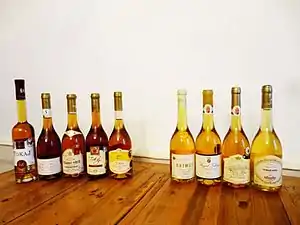
Tokaj wine is, by its unique character, a luxurious commodity with a strong appeal to the international market.
The dispute started in 1964 when, for the first time, the then Czechoslovakia exported its excessive production of Tokaj wine to Austria, the market that used to be solely supplied with this commodity by Hungary. The conflict of interests was settled in a bilateral agreement according to which Slovakia - at the expense of the Czech beer-related concession on Hungarian part - was only allowed to export its overproduction of Tokaj wine to Hungary (which consequently re-labeled and re-exported it). This agreement expired in 1990 after which date the dispute arose again.[10] In November 2012, the European Court ruled against Hungary’s request to erase the Slovak entry “Vinohradnícka oblasť Tokaj” from “E-Bacchus”, an electronic database containing a register of designations of origin and geographical indications protected in the EU. Hungary lodged an appeal against the judgement of the General Court. In February 2013, the EU Court of Justice has turned down the Hungarian appeal against an earlier ruling concerning Slovakia's registration of “Vinohradnícka oblasť Tokaj” (Tokaj Wine Region), which contains the name of Hungary’s Tokaj region. In its ruling, the court said that Slovakia’s registering its “Vinohradnícka oblasť Tokaj” in the European database E-Bacchus did not constitute an actionable measure.[11] As a result, under the current EU legislation the wine-growing region of Tokaj is located in both Hungary and Slovakia. Therefore, wine producers from both the Hungarian Tokaj region and the Slovak Tokaj region may use the Tokaj brand name.[3]
See also
- Slovak wine
- Tokaj wine region (also Tokaj-Hegyalja wine region or Tokaj-Hegyalja) of Hungary
- Tokaji (Hungarian wines)
References
- "Slovakia, a Land of Wine" (PDF). (328 KB) Slovak Union of Grape and Wine Producers. pp. 21-23. www.slovakia.travel
- Tokaj Regnum Archived 2010-09-17 at the Wayback Machine - Association of wine producers of Slovakian Tokaj
- "E-Bacchus - Register of designations of origin and geographical indications protected in the EU". Retrieved 2 June 2017.
- "Vinári začnú od júna opäť používať na etiketách názov Tokaj" (in Slovak). 2010. Retrieved 2010-10-01.
- Zemplén Vármegye és Sátoraljaújhely r. t. város, Budapest, 1905
- Lambert-Gócs, Miles. Tokaji Wine: Fame, Fate, Tradition. Board and Bench Publishing, 2010, ISBN 978-1934259498
- Žadanský, Juraj. Z dejín a súčasnosti tokajského vinohradníctva a vinárstva. Vlastivedné múzeum, Trebišov, 2009, ISBN 978-8089412075
- "Tokaj wine region of Slovakia". www.indianwineacademy.com. Retrieved 2 June 2017.
- "All About Shipping » Blog Archive » Tasting success: Slovakia decants its Tokaj wine…". Retrieved 2 June 2017.
- "Bitka o víno kráľov, kráľa vín. Slovensko-maďarské spory o značku Tokaj sa ťahajú už 34 rokov" (in Slovak). 2008. Archived from the original on 2008-12-08. Retrieved 2010-02-11.
- "European Commission - PRESS RELEASES - Press release - The Court of Justice declares that the listing of the Slovak wine name 'Vinohradnícka oblasť Tokaj' in the E-Bacchus register of protected designations of origin does not constitute an actionable measure". europa.eu. Retrieved 2 June 2017.
External links
- Tokajska Vinna Cesta - Wine Route in Slovakian Tokaj
- Tokaj Regnum - Association of wine producers of Slovakian Tokaj
- Slovakia decants its Tokaj Wine - Article about Slovakian Tokaj
- "Slovakia, a Land of Wine" (PDF). (328 KB) Slovak Union of Grape and Wine Producers. pp. 21–23. www.slovakia.travel
- Putting Slovak Tokaj Back on the Map - Article about the Project of mapping the Slovak portion of Tokaj wine Region
Further reading
- Žadanský, Juraj. Z dejín a súčasnosti tokajského vinohradníctva a vinárstva. Vlastivedné múzeum, Trebišov, 2009, ISBN 978-8089412075
- Lambert-Gócs, Miles. Tokaji Wine: Fame, Fate, Tradition. Board and Bench Publishing, 2010, ISBN 978-1934259498
- "Slovakia, a Land of Wine" (PDF). (328 KB) Slovak Union of Grape and Wine Producers. pp. 21–23. www.slovakia.travel